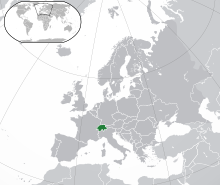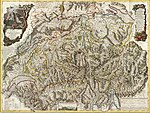
Back تاريخ اليهود في سويسرا Arabic Židé ve Švýcarsku Czech Judentum in der Schweiz German Histoire des Juifs en Suisse French יהדות שווייץ HE Ebraismo in Svizzera Italian Geschiedenis van de Joden in Zwitserland Dutch Židia vo Švajčiarsku Slovak İsviçre'deki Yahudilerin tarihi Turkish Історія євреїв у Швейцарії Ukrainian
 The location of Switzerland (dark green) in Europe | |
| Total population | |
|---|---|
| 20,000[1] | |
| Regions with significant populations | |
| Zürich, Geneva and Basel | |
| Languages | |
| Swiss German, Swiss Standard German, Swiss French, Swiss Italian, Romansh, Hebrew, Yiddish | |
| Religion | |
| Judaism |
| Part of a series on |
| Jews and Judaism |
|---|
| History of Switzerland |
|---|
 |
| Early history |
| Old Swiss Confederacy |
|
| Transitional period |
|
| Modern history |
|
| Timeline |
| Topical |
|
|



The history of the Jews in Switzerland extends back at least a thousand years. Jews and Judaism have been present in the territory of what is now Switzerland since before the emergence of the medieval Old Swiss Confederacy in the 13th century (the first communities settling in Basel in 1214).
Switzerland has Europe's tenth-largest Jewish community, with about 20,000 Jews,[1] roughly 0.4% of the population. The majority of the Jewish communities are domiciled in the largest cities of the country, i.e. in Zürich, Geneva and Basel.
The first World Zionist Congress of 1897 was held in Basel, and took place ten times in the city — more than in any other city in the world. Basel is also home to the Jewish Museum of Switzerland, the first Jewish museum to have been opened in German-speaking Europe after the Second World War. Whereas the communities of Basel and Zürich are traditionally shaped by large Ashkenazi communities, Geneva also hosts an important Sephardic community. Its main synagogue, the Synagogue Hekhal Haness, is considered to be the most important Sephardic synagogue in Switzerland.
- ^ a b Hein, Avi. "The Virtual Jewish World — Switzerland". Jewish Virtual Library. Retrieved 12 December 2015.
© MMXXIII Rich X Search. We shall prevail. All rights reserved. Rich X Search